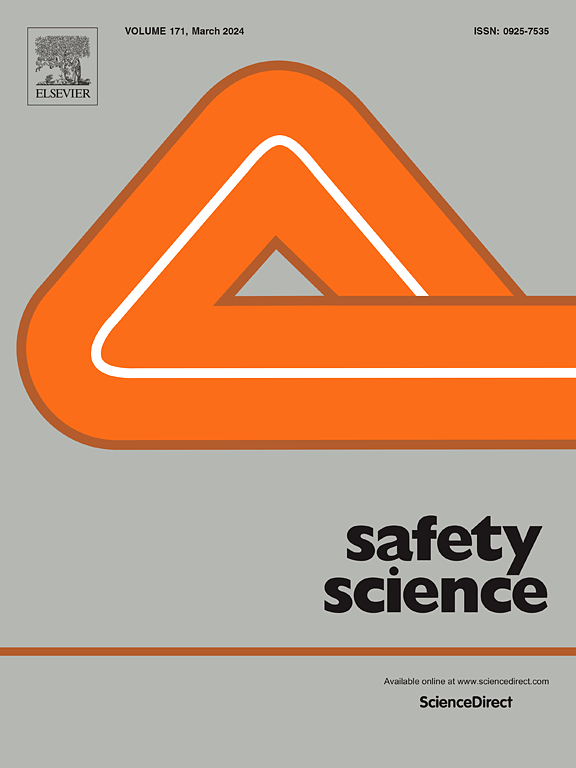Numerical simulation on the compartment safety of solid propellant storage under accidental jet fire
IF 4.7
1区 工程技术
Q1 ENGINEERING, INDUSTRIAL
引用次数: 0
Abstract
During the storage process of solid rocket motors (SRM), unintentional operations may lead to uncontrolled internal propellant combustion, which threatens to adjacent rocket motors and results in catastrophic outcomes. Consequently, the safety of storing SRM is a critical concern. In this paper, the Computational Fluid Dynamics (CFD) numerical simulation method is applied. The structure and flow parameters of the flow field are obtained using the Naiver-Stokes (N-S) control equations, the Realizable k-epsilon turbulence model, and the finite rate model. We investigate the hazardous properties of a standard storage compartment equipped with an exhaust cover and spray system in the event of an accidental jet fire. Furthermore, the safety parameters of the storage compartment are examined. The results showed that the jet flame was initially directed at the side walls, spread to the upper part, and propagated throughout the storage compartment. Using the response times and thresholds of the temperature and pressure sensors, the study determined the optimal activation time for the pressure relief port and water spray system to be 0.4 s and 0.1 s, corresponding to a spray intensity of 0.5 kg/s. The synergistic effects of the pressure relief exhaust cover and spray mechanisms could quickly reduce the temperature of the compartment below the critical threshold of 500 K, thereby preventing thermal hazards associated with propellant combustion within 10 s. The optimal location and time of entry into the storage compartment are determined based on monitoring the mass fraction of gases in the compartment while maintaining temperature and pressure safety limits. The results will provide theoretical foundations for improving secure memory design practices on SRM.
喷射起火事故下固体推进剂贮存舱安全的数值模拟
在固体火箭发动机(SRM)的储存过程中,无意的操作可能会导致内部推进剂燃烧失控,从而威胁到邻近的火箭发动机,造成灾难性后果。因此,固体火箭发动机的储存安全是一个至关重要的问题。本文采用了计算流体动力学(CFD)数值模拟方法。利用奈弗-斯托克斯(N-S)控制方程、可实现的 k-epsilon 湍流模型和有限速率模型获得了流场的结构和流动参数。我们研究了装有排气盖和喷淋系统的标准储藏室在意外喷射起火时的危险特性。此外,还考察了储藏室的安全参数。结果表明,喷射火焰最初指向侧壁,然后蔓延到上部,并扩散到整个储藏室。研究利用温度和压力传感器的响应时间和阈值,确定泄压口和喷水系统的最佳启动时间分别为 0.4 秒和 0.1 秒,对应的喷水强度为 0.5 公斤/秒。泄压排气盖和喷水机制的协同作用可迅速将舱室温度降至 500 K 临界值以下,从而在 10 秒内防止与推进剂燃烧相关的热危害。在保持温度和压力安全限制的前提下,根据对舱室内气体质量分数的监测确定进入储藏室的最佳位置和时间。研究结果将为改进 SRM 的安全存储器设计实践提供理论基础。
本文章由计算机程序翻译,如有差异,请以英文原文为准。
求助全文
约1分钟内获得全文
求助全文
来源期刊

Safety Science
管理科学-工程:工业
CiteScore
13.00
自引率
9.80%
发文量
335
审稿时长
53 days
期刊介绍:
Safety Science is multidisciplinary. Its contributors and its audience range from social scientists to engineers. The journal covers the physics and engineering of safety; its social, policy and organizational aspects; the assessment, management and communication of risks; the effectiveness of control and management techniques for safety; standardization, legislation, inspection, insurance, costing aspects, human behavior and safety and the like. Papers addressing the interfaces between technology, people and organizations are especially welcome.
 求助内容:
求助内容: 应助结果提醒方式:
应助结果提醒方式:


